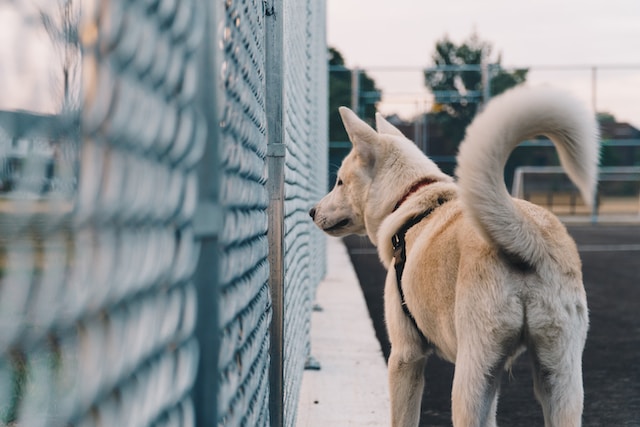Dogs are known for being man’s best friend, and for good reason. These loyal companions have been by our side for thousands of years, and they have become an essential part of our lives. As dog owners, it is important to understand our furry friends, including their body language. Dogs communicate primarily through body language, and by learning to interpret their signals, we can deepen our bond with them and ensure their happiness and well-being. In this blog post, we will explore some of the most common body language cues that dogs use to communicate with us.
Tail wagging

Tail wagging is one of the most recognizable signals of a dog’s body language. However, it is important to note that not all tail wags are created equal. A wagging tail can indicate a wide range of emotions, from happiness and excitement to fear and aggression. A loose, wide wag usually means the dog is happy and relaxed, while a stiff, high wag could indicate that the dog is feeling tense or agitated. Additionally, a tail tucked between the legs usually means the dog is feeling anxious or scared.
It’s important to remember that a wagging tail is not always an invitation to approach or interact with a dog. Even a seemingly friendly wag can be a warning sign that the dog is feeling uneasy or uncomfortable. Dogs may also wag their tails when they are in pain or experiencing discomfort, such as when they have an injury or illness. Additionally, some dogs may have naturally high or low tail carriage, which can impact the way their tail wags are perceived.

To properly interpret a dog’s tail wagging behavior, it’s important to consider the context and look for other signals in their body language. For example, if a dog is wagging their tail while backing away or crouching, they may be indicating that they are afraid or uncomfortable. Conversely, if a dog is wagging their tail while running towards you with an open mouth and relaxed body posture, they may be indicating that they are happy and playful. By paying attention to the entire context of a dog’s behavior, we can better understand their emotional state and respond appropriately.
Ear position

Another important aspect of a dog’s body language is their ear position. If a dog’s ears are relaxed and in a natural position, they are probably feeling calm and content. However, if their ears are pulled back against their head, it could indicate that they are feeling anxious or submissive. On the other hand, if their ears are perked up and facing forward, they are likely alert and interested in their surroundings.
In addition to their position, the movement of a dog’s ears can also provide insight into their emotions. For example, if a dog’s ears are constantly twitching or flicking back and forth, it could indicate that they are feeling nervous or unsure. Similarly, if their ears are pinned back and they are growling or baring their teeth, it could be a sign of aggression or fear.

It’s important to note that ear position can vary depending on the breed of dog. For example, some breeds, like the Scottish Terrier, naturally have ears that fold over, which can make it difficult to read their body language solely through their ear position. Additionally, dogs with cropped or docked ears may have difficulty expressing their emotions through their ears.
When interpreting a dog’s ear position, it’s important to consider it alongside other body language cues, such as tail position, facial expressions, and overall posture. By paying attention to the entire context of a dog’s behavior, we can better understand their emotional state and respond appropriately.
Eye contact

Eye contact is a powerful tool in communication, and this is true for dogs as well. If a dog is looking directly at you with relaxed eyes, it usually means they are feeling calm and comfortable. However, prolonged eye contact or a hard stare can be seen as a challenge or threat to a dog. It is important to avoid staring down a dog, as this can make them feel uncomfortable or even scared.
It’s also important to pay attention to the shape and size of a dog’s pupils when interpreting their eye contact. If a dog’s pupils are dilated or enlarged, it can indicate that they are feeling aroused or excited. Conversely, if their pupils are constricted or small, it could indicate that they are feeling stressed or anxious.

It’s worth noting that some dogs may have a natural tendency to avoid eye contact, especially if they have experienced trauma or abuse in the past. In these cases, direct eye contact may make the dog feel even more uncomfortable or scared. Instead, it’s important to give these dogs space and time to approach you on their own terms.
Overall, eye contact is just one aspect of a dog’s body language, and it’s important to consider it alongside other cues, such as ear position and tail wagging. By paying attention to the entire context of a dog’s behavior, we can better understand their emotional state and respond appropriately.
Body posture

A dog’s overall body posture can also give us clues about how they are feeling. If a dog is standing with their weight evenly distributed on all four legs, they are probably feeling relaxed and comfortable. However, if they are crouched down with their weight shifted forward, it could indicate that they are feeling defensive or ready to spring into action. Additionally, a dog that is rolling over onto their back is usually indicating that they are feeling submissive or trying to show trust.
Similarly, a dog that is standing tall with their head held high and their tail held erect is usually feeling confident and alert. However, if their hackles are raised (the fur on their back and neck stands up), it could indicate that they are feeling threatened or aggressive. It’s important to note that a dog’s body posture can change rapidly depending on their surroundings and the stimuli they encounter.

By paying attention to a dog’s overall body language, we can get a better understanding of their emotions and intentions. This can help us to interact with them in a way that is respectful and safe for both the dog and ourselves. Understanding and respecting a dog’s body language is a crucial part of building a strong and positive relationship with them, and it can lead to a happier and healthier life together.
Facial expressions

Finally, a dog’s facial expressions can also give us insights into their emotional state. A relaxed, open mouth usually indicates that a dog is feeling comfortable and content, while a closed mouth or a wrinkled nose can indicate anxiety or aggression. Additionally, if a dog is showing their teeth or snarling, it is a clear sign that they are feeling threatened and may become aggressive if they feel further provoked.
A dog’s facial expressions can also be subtle and quick, so it’s important to pay close attention to the details. For example, a dog that is yawning, licking their lips, or avoiding eye contact may be feeling stressed or uncomfortable in their environment. By understanding and responding to these facial cues, we can help a dog feel more comfortable and safe.

It’s also worth noting that some breeds and individual dogs may have unique facial expressions or quirks. For example, a wrinkled forehead on a Bulldog or a tilted head on a Beagle may be a normal part of their breed-specific appearance. However, it’s still important to pay attention to changes in a dog’s facial expressions over time, as this can be a sign of a health issue or a change in their emotional state.
Overall, understanding a dog’s body language requires observation, patience, and a willingness to learn. By paying attention to their tail wagging, ear position, eye contact, body posture, and facial expressions, we can better understand their emotions and respond in a way that is respectful and safe for everyone involved.
Conclusion
Understanding your dog’s body language is essential for building a strong and healthy relationship with them. By paying attention to their signals, we can better respond to their needs and ensure their happiness and well-being. Remember, dogs are not just pets, they are members of our families, and by learning to communicate with them effectively, we can deepen our bond and create a lifetime of love and companionship.
